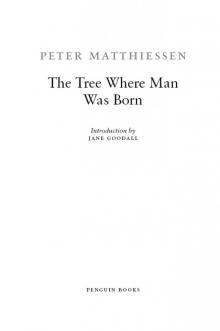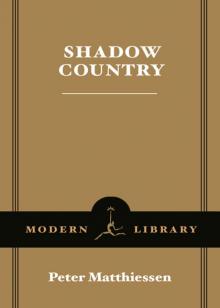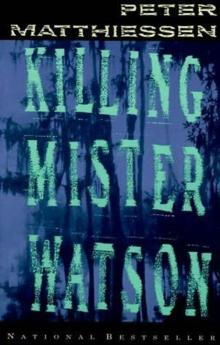- Home
- Peter Matthiessen
Sal Si Puedes (Escape if You Can) Page 6
Sal Si Puedes (Escape if You Can) Read online
Page 6
A Filipino in his sixties came up with a fine wordless smile and pumped Chavez’s hand in both his own. “That’s one of the brothers,” Chavez explained when the old man had gone; the term “brother” or “sister” is used to describe a Union member, but it also has the connotation of “soul brother,” and is so used by Chavez when addressing strangers.
Father Mark Day, a young Franciscan priest who was assigned to the farm workers in 1967, came up and greeted Chavez heartily. The following Sunday, he said, the Catholic churches of Delano would speak out in favor of the workers’ right to form a union; hearing this, Chavez merely nodded. Since 1891, papal encyclicals have affirmed the workers’ right to organize—Pope John XXIII had even spoken of their right to strike—but in Chavez’s opinion Catholic help has too often taken the form of food baskets for the needy rather than programs that might encourage independence: a union and a decent wage would enable the worker to escape from demeaning and demoralizing dependence on welfare and charity. Although individuals in the clergy around the country had lent sympathy to the farm workers very early, and many outside church groups, particularly the Migrant Ministry, had long ago come to his support, with personnel as well as money, the clergy, Catholic as well as Protestant, had denounced the grape strike or dodged the issue for fear of offending the growers, most of whom are Catholics of Italian or Yugoslav origin and contribute heavily to the Church. In fact, when Chavez’s organization, the National Farm Workers Association, began the strike in 1965, the growers were able to pressure the Church into forbidding NFWA to use the parish hall of Our Lady of Guadalupe. (“I find it frankly quite embarrassing,” Father Day has said, “to see liberals and agnostics fighting vehemently for social justice among agricultural workers while Catholic priests sit by and sell them religious trinkets.”) Though more and more embarrassed by the example of outside clergy of all faiths, many of whom had marched in the Union picket lines, it was only recently that the Delano clergy abandoned its passive stance and joined in attempts to reconcile the growers to the Union. Now Father Day spoke of the large Zaninovich clan, some of whom came to mass here at Our Lady of Guadalupe. “If they would just get together with their workers,” he said, “we wouldn’t have any problems.”
Chavez looked doubtful, but he nodded politely. “Yes,” he said after a moment, “this church is really coming to life.” With Chavez, it is sometimes hard to tell when he is joking and when he is serious, because he is so often both at the same time.
More people greeted him, “¿Va bien?” “¡Está bien!” Most of the people are jocular with Chavez, who has a warm, humorous smile that makes them laugh, but after the joking, a few stood apart and stared at him with honest joy.
A worker in a soiled white shirt with a fighting cock in bright colors on the pocket stood waiting for a hearing. Though Chavez is available to his people day and night, it is on Sunday that they usually come to see him, and his Sundays are all devoted to this purpose. “. . . buscando trabajo,” I heard the worker say when he had Chavez’s ear: he was looking for work. He had just come in from Mexico, and the visa, or “green card,” that he carried in his pocket is the symbol of the most serious obstacle that Chavez’s strike effort must face: the century-old effort of California farmers to depress wages and undercut resistance by pitting one group of poor people against another.
By the 1860’s the local Indians used as near-slaves in Spanish California had been decimated; they were largely replaced, after the Gold Rush, by Chinese labor made available by the completion of the Southern Pacific railroad. But the thrifty Chinese were resented and persecuted by the crowds of jobless whites for whom the Gold Rush had not panned out, and also by small farmers, who could not compete with the cheap labor force, and when their immigration was ended by the Exclusion Act of 1882, the big farmers hired other immigrants, notably Japanese. The Japanese undercut all other labor, but soon they too were bitterly resented for attempting to defend their interests. Even worse, they were better farmers than the Americans, and they bought and cultivated poor ground that nobody else had bothered with; this impertinence was dealt with by the Alien Land Law of 1913, which permitted simple confiscation of their land. (The land was subsequently restored, then confiscated again after Pearl Harbor.)
The next wave of farm laborers in California contained Hindus (Sikhs), Armenians and Europeans; they slowly replaced the Japanese, who by 1917 were referred to as the “yellow peril,” and after the war, for patriotic reasons, were kicked out of their jobs to make room for red-blooded Americans. Meanwhile, the European and Armenian immigrants, less beset than the Asiatics by the race hatred that has advanced the economy of California from the start, were gaining a strong foothold; many were the parents of the Valley farmers of today.
Throughout the nineteenth century, Mexican peasants had crossed the border more or less at will. After the Mexican Revolution of 1910, the starving refugees presented the growers with a new source of cheap labor which, because it was there illegally, had the additional advantage of being defenseless. Cheap Mexican labor was pitted against cheap Filipino labor; the Filipinos were brought in numbers in the twenties. Many of the Mexicans were deported after 1931, when the Okies, Arkies and up-country Texans swarmed into California from the dust bowls; the Depression had caused a labor surplus beyond the wildest dreams of the employers, and an effort was made to keep the border closed.
Still, Mexicans were predominant in the farm labor force from 1914 until 1934. In these years, because of their illegal status, they tended to be more tractable than other groups; the famous farm strikes of the thirties occurred more often among Anglos and Filipinos. Despite their quiet nature, the Filipinos refused to scab on other workers or underbid them. “The Filipino is a real fighter,” Carey McWilliams wrote in Factories in the Fields, “and his strikes have been dangerous.” Few Filipino women had immigrated, and the ratio of men to women was 14 to 1; predictably, the growers dismissed the Filipinos as “homosexuals.” McWilliams quotes the Pacific Rural Press for May 9, 1936, which called the Filipino “the most worthless, unscrupulous, shiftless, diseased semi-barbarian that has ever come to our shores.” After the Philippine independence act of 1934, further importation of the spirited Filipinos came to an end, and their numbers have been dwindling ever since.
By 1942 the Chinese were long since in the cities, the Japanese-Americans had been shut up in concentration camps, the Europeans had graduated from the labor force and become farmers, and the Anglos had mostly drifted into the booming war economy of factories and shipyards; the minority groups that remained were not numerous enough to harvest the enormous produce that the war demanded.
The farm labor emergency was met by a series of agreements with the Mexican government known collectively as the bracero program, under the terms of which large numbers of day laborers, or braceros, were brought into California and the Southwest at harvest time and trucked out again when the harvest was over. The bracero program was so popular with the growers that it was extended when the war was over. In Washington the lobbyists for the growers argued successfully that Americans would not do the hard stoop labor required in harvesting cotton, sugar beets, and other crops; hence the need for the extension of the bracero program. Everyone conveniently forgot that the white fruit tramps of the thirties had done plenty of stoop labor and that domestic workers of all colors would be available to the farms if working conditions were improved. But the Mexicans, whose poverty was desperate, worked hard long days for pay as low as 60 cents an hour, and were used to undermine all efforts by domestic workers to hold out for better treatment; by 1959 an estimated four hundred thousand foreign workers (including small numbers of Canadians in the potato fields of Maine, and British West Indians in the Florida citrus groves) were obtaining work in an America where millions were unemployed.
Already the churches and citizens’ groups were protesting the lot of the farm workers, and the domestic migrant laborers especially, and at the end of 1964 Public Law 78, the la
st and most notorious of the bracero programs, was allowed to lapse. (This was the year in which a long-accumulating sense of national guilt had permitted the passage of significant poverty and civil rights legislation, and it would be pleasant to assume that P.L. 78 was a casualty of the new humanism, but congressional concern about the outflow of gold was probably more important.)
The death of P.L. 78 was the birth of serious hope for a farm union, but by 1965, when the grape strike began, the growers had found another means to obtain the same cheap labor. Under Public Law 414 (the Immigration and Nationality Act of 1952, also called the McCarran-Walter Act), large numbers of foreigners were permitted to enter the United States as “permanent resident aliens” on a special green visa card. “Green-carders” could become citizens after five years’ residence (and hold social security, pay taxes, and be drafted while they waited), but since the Mexican may earn fifteen times as much for a day’s work in the United States ($30 versus 25 pesos, or about $2), most have declined this opportunity in favor of “commuting,” i.e., they cluster around the border towns and take their high harvest wages—an estimated $15 million worth in 1967—back to Mexico.
Today almost half the membership of Chavez’s union hold green cards; they are welcome so long as they do not work as scabs. The law specifies that no green-carders may work in a field where a labor dispute has been certified, or where a minimum wage (now $1.40 an hour) has not been offered first to domestic workers, but enforcement of this law has been desultory, to say the least. Many Mexicans, with the active encouragement of the growers and the passive encouragement of the Border Patrol of the U.S. Immigration Service, have joined the numerous “wetbacks” (that is, the illegal immigrants) as strikebreakers. As long as they are excluded from legislation that guarantees collective bargaining, the farm workers have no formal means to force employers to negotiate. When their strike against the grape growers was subverted by imported scabs and antipicketing injunctions, they were driven to what the growers call an “illegal and immoral” boycott. Originally this boycott was directed against one company, the Joseph Giumarra Vineyards, Inc., but Giumarra began selling its products under the labels of other companies, and in January 1968 the present consumer’s boycott against all growers of California table grapes was begun.
In the autumn of 1968, according to the Fresno Bee of November 3, an estimated twenty to thirty thousand wetbacks were working in the Valley; though their presence is illegal, there is no penalty for hiring them, and since they are both economical and defenseless, the growers replace their domestic force with alambristas (fence jumpers) at every opportunity. “When the alambrista comes into a job,” one of them is quoted as saying, “the regular workers are out, just like that.” The Immigration Service picked up five hundred and ten wetbacks in the Delano area in August alone—about one fortieth of the lowest estimated number.
Loosely enforced, P.L. 414 is no improvement over P.L. 78, and it poses a moral problem as well as an economic one: Mexican-Americans, most of whom have parents or grandparents south of the border, have deep sympathy with Mexican poverty and do not wish to get Mexicans into trouble by reporting them to la Migra, as the Border Patrol is known. Besides, many green-carders are innocent, having been hired without being told, as P.L. 414 requires, that their employer was the object of a strike; some of these people, poor though they are, have walked off the job in a strange country when they learned the truth, but most are in debt for transport and lodging before they ever reach the fields, and their need—and that of their families at home—is too great to permit so brave a gesture.
The man with the fighting cock on his shirt was a Union green-carder who did not wish to cross the picket lines. But at that time there were more Union workers than Union jobs—only three growers in the Delano area had signed contracts with the United Farm Workers Organizing Committee—and Chavez encouraged the man to take a job wherever he could find it. He did not have to encourage the green-carder to help the Union on the job by organizing work slowdowns; the man was already complaining that social security payments had been deducted from his last pay checks, even though no one had asked for his social security number.
Workers who cannot read, like this man, feel that they are chronic victims of petty pay-check chiseling on the part of both labor contractors and growers, not only on illusory social security but on unpaid overtime and promised bonuses. (In the first six months of 1967, the Department of Labor discovered that nearly two hundred thousand American laborers were being cheated by their employers, mostly on unpaid overtime and evasion of the minimum wage; this figure is probably only a fraction of the actual number of victims.) Chavez feels that the labor contractor, who sells his own people in job lots to the growers, is the worst evil in an evil system that is very close to peonage; the contractor would be eliminated if the growers agreed to get their labor through a union hiring hall.
“Those people make a lot of money that way,” Chavez said. “A lot.” At this moment, he looked ugly. “In the Union, the workers get an honest day’s pay, because both sides understand the arrangement and accept it. Without a union, the people are always cheated, and they are so innocent.” In silence, we walked on up Eleventh Avenue to Albany and turned south along the cotton fields. It was eight o’clock now, and the morning was hot. The flat farmland stretched away unbroken into dull mists of agricultural dust, nitrates and insecticides, still unsettled from the day before, that hid the round brown mountains of the Coast Range.
Chavez said that many of the green-carders—and especially those who would return to Mexico—felt they could beat the Union wage scale by working furiously on a piece-rate basis; others did not join the Union out of ignorance—they had never heard of a union—or fear of reprisal. “It’s the whole system of fear, you know. The ones we’ve converted—well, out at Schenley we have a contract, and P. L. Vargas, on his ranch committee—there was a guy named Danny. Danny was so anti-Union that he went to the management at Schenley and said, ‘Give me a gun; I’ll go out and kill some of those strikers.’ He just hated us, and he didn’t know why. Today he’s a real good Unionist; he has a lot of guts and does a lot of work, but he still doesn’t know why. He was working inside when we came with the picket line, and he wouldn’t walk out, and I guess he felt guilty so he went too far the other way. And also, he told me later, ‘I didn’t know what a union was, I never heard of a union; I had no idea what it was or how it worked. I came from a small village down in Mexico!’ You see? It’s the old story. He was making more money than he had ever seen in Mexico, and the Union was a threat.
“Anyway, we won there, and got a union shop, and all the guys who went out on strike got their jobs back. And, man, they wanted to clean house, they wanted to get Danny, and I said no. ‘Well, he doesn’t want to join the Union! And the contract says if he doesn’t join the Union, he can’t work there!’ So I challenged them. I said, ‘One man threatens you? And you’ve got a contract? Do you know what the real challenge is? Not to get him out, but to get him in. If you were good organizers you’d get him, but you’re not—you’re lazy!’ So they went after Danny, and the pressure began to build against him. He was mad as hell, he held out for three months, and he was encouraged by the Anglos, the white guys—they had the best jobs, mechanics and all, and they didn’t want to join the Union either. But finally Danny saw the light, and they did too. That contract took about six months to negotiate, so by the time we got around to setting up a negotiating committee, Danny had not only been converted but had been elected to the committee. So when the committee walked in there, P. L. was one of them and Danny was another, and the employers stared at him: ‘What are you doing here, Danny?’” Chavez laughed. “And now he’s a real St. Paul; he’ll never turn against the Union because he knows both sides. People who don’t know, and come on so enthusiastic and all at first, they may be turncoats one day, but not the ones like Danny. That’s why the converted ones are our best men.
“You know how we make enem
ies? A guy gets out of high school, and his parents have been farm workers, so he gets a job, say, as a clerk at the Bank of America. This way, you know, he gets into the climate, into the atmosphere”—Chavez shook his head in bafflement—“and I’ll be damned if in two years they haven’t done a terrific job on him, not by telling him, but just by . . . by immersion, and before you know it the guy is actually saying there’s no discrimination! ‘Hell, there’s no poverty!’ See? He knows his place. Or he gets a job at a retail store and then feels threatened because our people are making more than he does. ‘Look,’ he says, ‘I went to high school for four years, so how come these farm workers are making more than I do?’ That really hurts. Either way he is threatened by the Union.”
On the left as we walked south on Albany were the small houses of large families, mostly Mexican. Though these houses are simple, their neatness reflects a dignity that was not possible in the labor camps, which have always been the ugliest symbol of the migrant workers’ plight. “Besides being so bad, they divide the families,” Chavez said. “We don’t want people living out there, we want them in their own houses. As long as they’re living in the camps, they’re under the thumb of the employer.” He nodded toward the small houses. “In Delano the need for housing is being met, even for the migrants. I mean, if we won the whole thing tomorrow, signed contracts with all the growers, we’d have to use some of the camps for a little while, but right now the people in the camps are strikebreakers.” I kicked a stone, and he watched it skid into the field. “We’re going to get rid of those camps,” he said, as if making himself a promise.
A car passed us, bursting with cries, and rattled to a halt a short way beyond. Two workers were driving a third to the Forty Acres, the site of the proposed new Union headquarters, and to my surprise—we had been headed for the Union offices at the corner of Albany and Asti streets—Chavez suggested that we ride out there. The car turned west at Garces Highway and rolled two miles through the cotton and alfalfa to a barren area of mud, shacks and unfinished construction on the north side of the road. Here the car left us and went back to town, and the third man, a solitary Anglo tramp, a renegade from the thirties who helps the farm workers whenever he comes to town, shouted cheerily at Chavez and marched off to water some scattered saplings that shriveled slowly in the August heat.

 Lost Man's River: Shadow Country Trilogy
Lost Man's River: Shadow Country Trilogy The Tree Where Man Was Born
The Tree Where Man Was Born The Snow leopard
The Snow leopard Sand Rivers
Sand Rivers The Cloud Forest
The Cloud Forest Sal Si Puedes (Escape if You Can)
Sal Si Puedes (Escape if You Can) Far Tortuga
Far Tortuga Men's Lives
Men's Lives On the River Styx: And Other Stories
On the River Styx: And Other Stories Shadow Country
Shadow Country At Play in the Fields of the Lord
At Play in the Fields of the Lord Lost Man's River
Lost Man's River Killing Mister Watson
Killing Mister Watson On the River Styx
On the River Styx